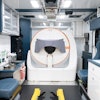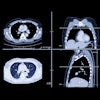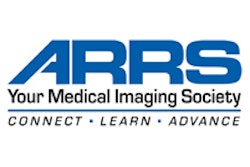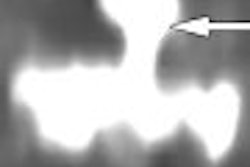This article originally appeared in the American Journal of Roentgenology. Author Dr. Howard Forman is an associate editor of health policy for the American Journal of Roentgenology. Co-author Dr. Christoph Lee is from the department of radiology at Stanford University School of Medicine in Stanford, CA.

If these estimates hold up over time, then CT screening for lung cancer may be a promising diagnostic tool for decreasing the mortality rate from an aggressive disease that continues to be the most common cause of cancer death in the U.S. The benefits noted in the study in terms of mortality rate are striking. However, some would argue that there is still a lack of evidence that the benefits of CT screening for lung cancer in asymptomatic patients actually outweigh the risks and costs, particularly since the question remains unanswered regarding the effectiveness of early intervention in patients found to have a lung lesion.
Henschke et al present the medical community with a case-control observational study without a randomized control comparison. Statistical models are used to estimate survival past three years. Lead-time bias and overdiagnosis cannot be overlooked when using survival as a metric. The study results rely on the assumption that early detection will result in a cure of an earlier stage of disease. Yet, due to lead-time bias, CT screening may find cancer but still not affect life expectancy.
In addition to the questions raised about the methodology of this study, larger questions remain concerning the use of CT screening for lung cancer. Most radiologists agree that CT screening is not specific for lung cancer and the technique cannot differentiate between benign and malignant tumor. Incidental abnormalities on chest CT scans are common findings that require proper diagnostic workup and management.
Ruling out cancer means more physician and other healthcare provider resources (which are in high demand and short supply), and can mean complications from biopsies and wedge resections. In addition, quality of life and productivity of patients may be compromised by further diagnostic workup of incidental abnormalities found during CT screening. There are also radiation-associated risks that should be carefully considered.
Although widespread screening is currently not supported by leading U.S. groups, the popularity and interest in CT screening for lung cancer will likely outpace the availability of evidence of its efficacy from pending randomized controlled trials. The increased publicity of CT screening will spur demand among concerned patients and pressure among the medical community to act upon that demand. As the gatekeepers of CT screening, the radiology community must be ready to respond appropriately to that demand.
As physicians, we have taken an oath to do no harm. Screening of "high-risk" patients in the U.S. will lead to increased radiation risk in both the individual and the population. The effective radiation dose from "low-dose" lung cancer screening CT (2.5-9 mGy) is still in a range experienced by atomic bomb survivors who had a statistically significant increase in solid cancer risk and cancer mortality. Abnormal findings on an initial exam will likely decrease the amount of time between follow-up CT exams for the individual patient. With repeated exams to document tumor growth, how many cancers will we inadvertently be causing?
The risk of radiation-induced lung cancer is known to be highest in those in their mid-50s as opposed to radiation-induced cancer in other areas of the body. Moreover, there is purported synergy between damage from smoking and damage from radiation. While single CT lung screening exams entail a very small radiation risk, repetitive scans to a single individual over 25 years can increase that patient's lung cancer risk significantly. From the perspective of the current U.S. population of smokers, former smokers, and those exposed to secondhand smoke, annual screening from ages 50 to 75 could result in thousands of radiation-induced lung cancers, according to a study published in Radiology (May 2004, Vol. 231: 2, pp. 440-445).
Even in the "high-risk" population, the overwhelming majority of noncalcified lung nodules will be benign, which means that biopsies of benign lesions will not be uncommon. Invasive procedures will be performed for false-positive results. Resection for benign disease will be a real possibility. As a result, the patient's quality of life will suffer during this continuum of ineffective diagnostic and therapeutic intervention with increased anxiety and loss of productivity. Both ethically and legally, this can be construed as inflicting undue harm on the patient ultimately found to have a benign lesion.
Accompanying these intangible costs to patients' health are the actual economic costs of an unproven technology. While CT screening for lung cancer is currently not reimbursed by most third-party payors, all follow-up diagnostic studies and interventions for abnormal findings are typically paid by insurers. If CT screening for lung cancer becomes a mainstream trend, then the question must be posed as to whether society can afford to spend billions of dollars on CT screening and follow-up expenses in light of other essential aspects of healthcare.
The associated costs will require serious expenditures from the constrained pot of Medicare, Medicaid, and employer-based health insurance plans. These increased health expenditures will be passed on to the public through increases in insurance premiums and to the provider in the form of decreased reimbursements. Moreover, resources for screening asymptomatic patients may be taken from some other, possibly more essential, aspect of healthcare. Thus, from the perspective of social justice, CT screening will add to the debate about proper access to care in the U.S.
Many of the issues we have raised thus far fall into three of the principles of medical ethics: nonmaleficence, beneficence, and justice. So how will these issues be resolved?
The questions about beneficence hopefully will be answered through prospective randomized controlled trials that can help quantify the benefit, if any, of CT screening for decreasing overall mortality of stage I lung cancer. In terms of nonmaleficence, further discussion is necessary on what risks will be deemed acceptable from both the individual patient and population perspectives.
In particular, will the estimated radiation-induced cancers and increased morbidity and mortality from interventions for false-positive results be acceptable in the face of presumed benefits? As for access to care and effective use of health resources, more studies are needed to determine the actual cost-effectiveness of CT screening.
What can we, as radiologists, do as demand increases for CT screening for lung cancer? With direct-to-consumer marketing from outpatient screening centers and medical information readily available via the Internet, it will likely be patient demand that will drive CT screening. One answer lies in the fourth principle of medical ethics -- patient autonomy. Proper informed consent may go a long way toward discouraging the misuse of CT screening.
Before any CT screening is to take place, the physician or radiologist should outline the benefits, risks, alternatives, and associated costs (emotional, physical, and economic). Patients will need to be informed about possible radiation-induced cancer with increasing risk associated with each subsequent exposure. Patients should be informed that any abnormal finding would require follow-up CT, that false positives will be common, and that the patient may have to undergo biopsies, therapeutic procedures, diagnostic wedge resection, or even surgery for any suspicious lesion without the guarantee of finding malignancy.
In addition, the radiology community must work with referring physicians to clearly identify and define "high-risk" populations, and ensure that all risks and benefits are clearly outlined to patients at each step of the diagnostic process. Without consensus on a uniform approach to informed consent, both patients and the medical community will inevitably be exposed to unnecessary risks and expenses.
As radiologists, we are positioned to be central figures in the exciting endeavor of CT screening for lung cancer. We should be optimistic about the possible social benefits that this new technology promises; however, we should cautiously move forward and continually evaluate the associated risks, then properly relay these findings to patients during each step of the screening process so they can make educated decisions.
The results of randomized controlled trials examining the survival benefits of CT screening for lung cancer will be awaited eagerly. Also, further research will be required regarding alternatives and adjuncts to CT screening, including possible biomarkers for detecting early lung cancer. More detailed cost-effectiveness models are needed to project economic and quality-of-life costs associated with CT screening for both the individual and society. In essence, a lot more research must be done before we should yield to an increased demand for CT screening for lung cancer. This research is essential to properly inform patients about the benefits, possible risks, associated costs, and alternatives to CT screening for lung cancer and to prevent misuse of health resources.
Although the Henschke et al study answered some questions, two important questions now must be answered: At what cost will we be screening asymptomatic patients with CT; and what steps can we take now to be socially responsible for the well-being of our patients, our society, and our profession?
By Dr. Howard Forman and Dr. Christoph Lee
AuntMinnie.com contributing writers
April 10, 2007
This article originally appeared in the American Journal of Roentgenology (February 2007, Vol. 188:2, pp. 297-298). Reprinted by permission of the ARRS.
The opinions expressed in this policy brief are those of Drs. Forman and Lee; they do not necessarily reflect the viewpoint or position of the American Roentgen Ray Society, the Stanford University School of Medicine, Yale University, or AuntMinnie.com.
Related Reading
Major changes in the radiology residency program requirements are coming, December 5, 2006
The radiology job market: Help wanted, November 23, 2006
How to win the coronary CTA turf war, October 9, 2006
MRI and CT imaging: How fast can reimbursement be cut?, September 20, 2006
Radiology reimbursement faces major changes, August 21, 2006
Copyright © 2007 American Roentgen Ray Society




















